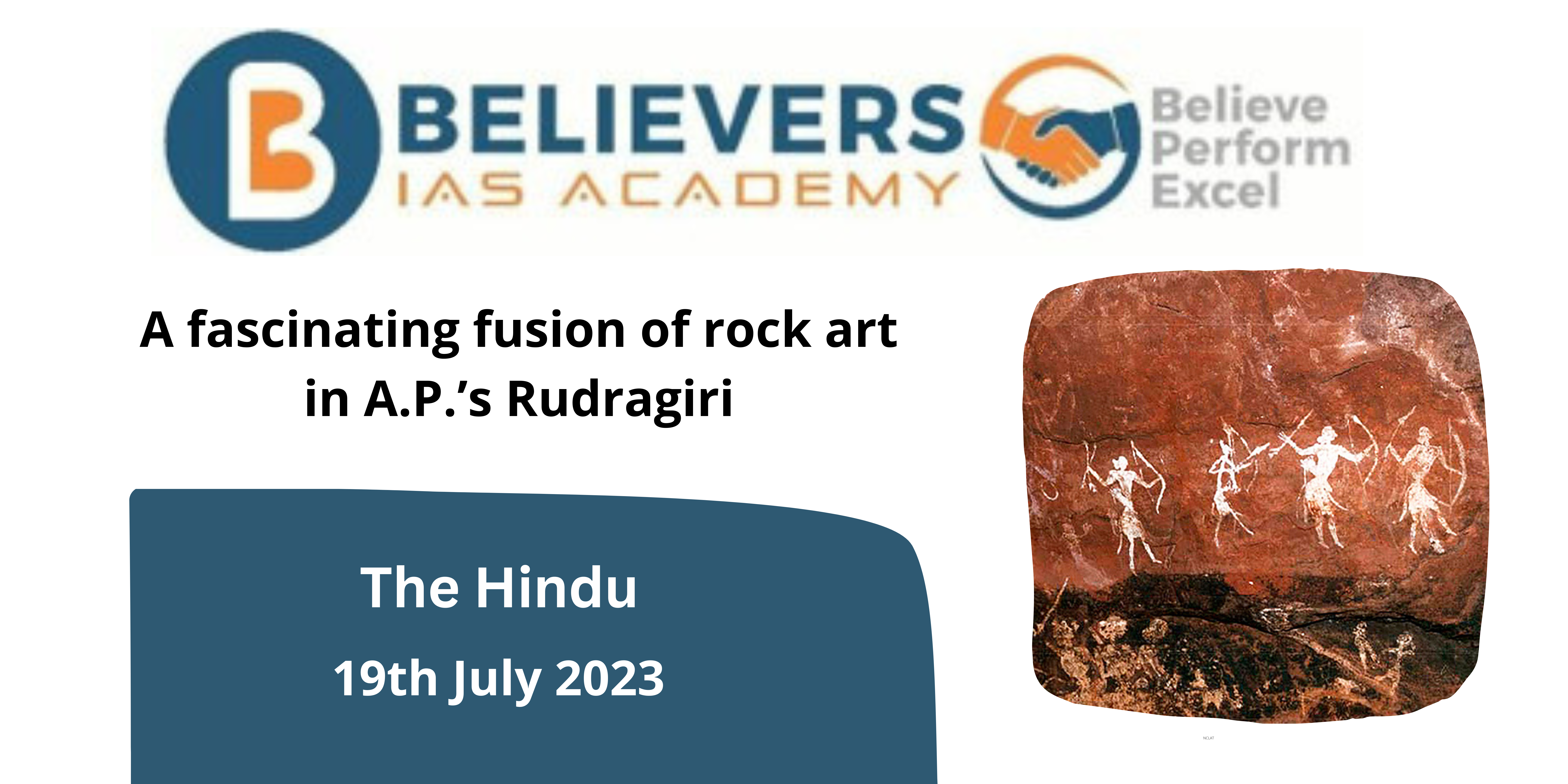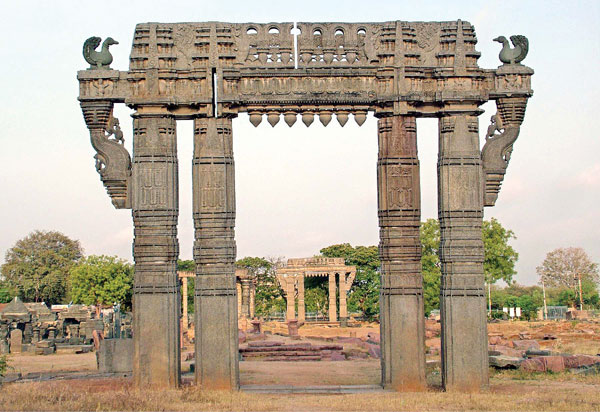A Fascinating Fusion of Rock Art in A.P.’s Rudragiri
Context
The remarkable fusion of Mesolithic prehistoric rock art and beautiful Kakatiya dynasty artwork is revealed at the Rudragiri hilltop location. The significance of this undiscovered treasure was clarified by D. Kanna Babu, former Superintending Archaeologist of the Temple Survey Project (Southern Region) at the Archaeological Survey of India. He shared his findings with The Hindu.
What paintings were found at the RudraGiri sites?
At the slopes of Rudragiri, five naturally occurring rock shelters once housed people during the Mesolithic era. Prehistoric rock art from that time can be seen in these shelters.
- First Cave: Beginning at the southern tip of the hillock, the first cave displays a narrative fresco illustrating the fierce conflict between the Vanara brothers, Vali and Sugriva.
- Middle Cave: A magnificent drawing of Hanuman, the venerable monkey god, clutching the Sanjivani hill in his palm as a representation of his quest to save Lakshmana’s life, can be seen there. The sacred conch (Sankha) and fire altar (Yagna Vedi) emblems are presented beside the drawing.
- Third cave: Prehistoric rock art from the Mesolithic period is kept in the third cave. Curiously, the Kakatiya artist used the same rock shelter to superimpose the image of Hanuman in the unusual “Anjali” pose, with his hands folded in a prayerful offering.
What did we know of the Kakatiya period?
- Background Information: From the 12th through the 14th century, the Telugu-speaking Kakatiya dynasty dominated the majority of present-day India’s eastern Deccan region.
- Area: The Kakatiya territory included a large portion of what is now Andhra Pradesh and Telangana, as well as slivers of eastern Karnataka, northern Tamil Nadu, and southern Odisha.
- Capital: Orugallu, presently known as Warangal, served as their capital city.

- Early monarchs: For more than two centuries, the Rashtrakutas and Western Chalukyas were feudatories of the early Kakatiya monarchs.
- Prataparudra I’s rule: In 1163 CE, the Kakatiyas consolidated their control over the Telangana region by putting down other Chalukya subordinates.
- Ganapathi Deva: Under Ganapati Deva (r. 1199–1262), the Kakatiya domains were greatly expanded in the 1230s. He gave Kakatiya power over the Telugu-speaking lowland delta regions near the Godavari and Krishna rivers.
- Decline and Consequences: After the Kakatiya kingdom fell, there was chaos and instability under numerous alien kings. The Telugu clans were eventually united by the Musunuri Nayaks, who also liberated Warangal from the Delhi Sultanate.
- Cultural unification: The Kakatiyas were instrumental in bringing the distinctive upland and lowland civilizations of Telugu territories together. As a result, Telugu speakers began to experience a sense of cultural kinship.
- Reservoirs for irrigation: The Kakatiyas were renowned for building reservoirs known as “tanks” for highland irrigation. These tanks are still in use in large numbers today.
- Unique Architecture: During the Kakatiya era, a unique architectural style that enhanced and innovated on preexisting styles arose. The Thousand Pillar Temple at Hanamkonda, the Ramappa Temple in Palampet, the Warangal Fort, the Golconda Fort, and the Kota Gullu in Ghanpur are notable examples. These buildings are outstanding illustrations of Kakatiya’s architectural accomplishments.
What do we understand of the Mesolithic life led here?
- Mesolithic Rock Paintings: At the foothills of Rudragiri, five naturally occurring rock shelters once housed people during the Mesolithic era. Prehistoric rock art from that time can be seen in these shelters.
- Artistic Techniques: The Mesolithic rock paintings were made utilizing the creative methods of the time, and they provide important insights into the way of life, the culture, and the aesthetic expressions of the Mesolithic people.
What does the art found in this region tell us?
- In addition, the Kakatiya dynasty, which governed the area in the 13th century A.D., left beautiful murals in two natural caves at the southern end of the mound.
- The Kakatiya artworks are examples of the time’s best artists. Even while some paintings have deteriorated over time from exposure to the elements, surviving sketches and outlines show the Kakatiya artists’ amazing artistry.
- The Kakatiya paintings are decorated with a range of hues made from white kaolin and various pigments, enhancing their brightness and richness.
- Ramayana is shown in the Kakatiya paintings, which offer insights into the cultural themes and oral traditions of the time. These paintings generally show enthralling scenes from the epic Ramayana. The paintings are embellished with various colours made from white kaolin and other pigments.
- The Kakatiya dynasty’s art reflects their worldview, which was predominantly Hinduism. Hindu deities’ temples were built, and they were ornamented with reliefs and sculptures showing scenes from the Ramayana and the Mahabharata, among other Hindu epics. These pieces of art shed light on the important mythical stories and religious rituals of the time.
In conclusion, the Rudragiri hilltop is a notable archaeological site that exhibits Mesolithic rock art as well as the artistic genius of the Kakatiya dynasty. Visitors can dig into the region’s ancient past with its remarkable fusion of historical accounts and creative manifestations.





